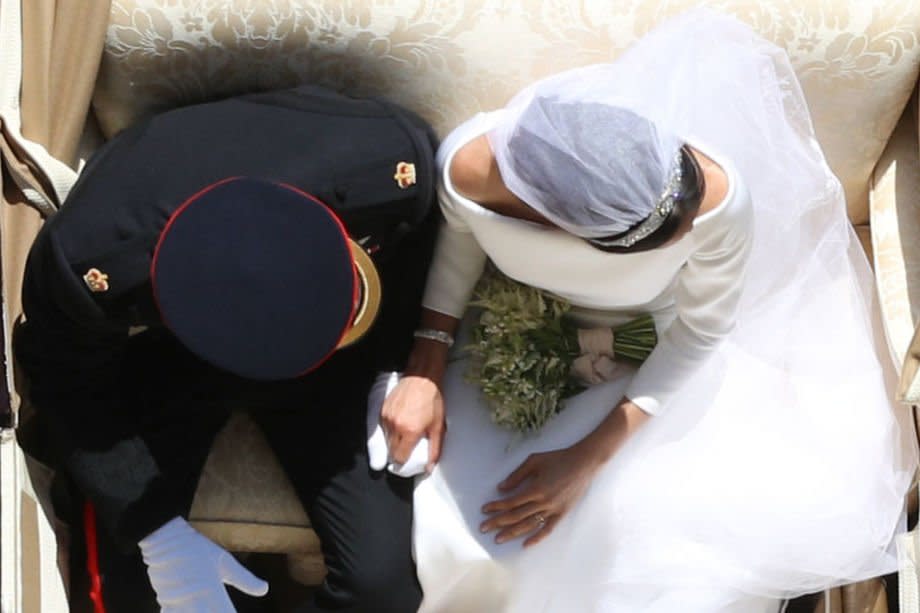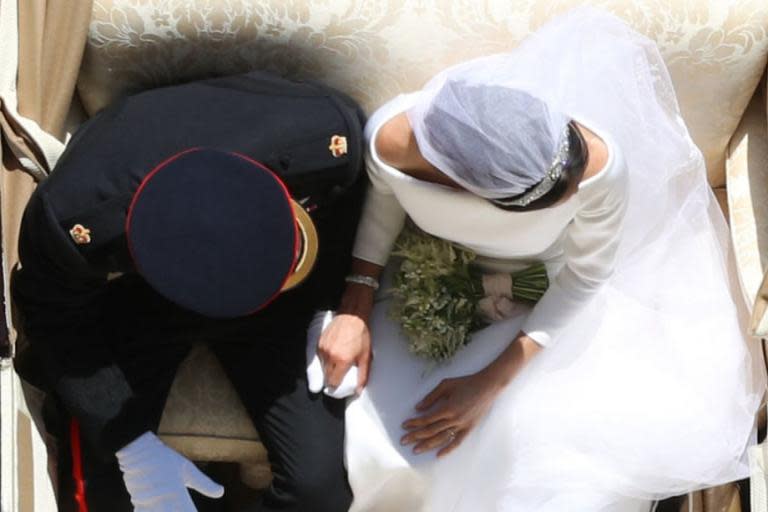Royal wedding photographer explains how he captured viral photo of Prince Harry and Meghan
The number of photos taken of the new Duke and Duchess of Sussex on Saturday was substantial to say the least.
However, one in particular has received a phenomenal response on social media thanks to the unique angle of the image.
Yui Mok, a staff photographer for Press Association, was standing on a roof in Windsor during Prince Harry and Meghan’s carriage procession when he captured an aerial shot of the couple.
The photo that he took provided an intimate birds-eye view of the newlyweds, showing them holding hands as their carriage was led around Windsor following their nuptials.
The touching image went viral on Twitter before social media users became aware of the photographer’s identity.
“I don’t know who took this picture, but it’s exquisite,” one person wrote in a tweet that’s garnered more than 14,000 retweets and more than 82,000 likes.
Mr Mok has since responded to the praise that his affecting photo has received, detailing how it came about on the day of the royal wedding.
I don't know who took this picture, but it's exquisite 💖👑 #RoyalWedding pic.twitter.com/yR60JWCdd1
— . . d r e . . (@LostNRealityTV) May 19, 2018
“I was positioned on the roof of the George IV Gateway of Windsor Castle, and they passed directly beneath me during their carriage procession,” he wrote on Twitter.
He explained that the composition of the photo, in which Prince Harry and Meghan form a "heart shape" with their hands, had been entirely serendipitous.
“I had less than a one-second window to take that particular shot - whilst having to focus through a metal grill I was standing over - so was happy to get anything really!”
Some had previously suspected that a drone had been used to photograph the royal couple from above.
However, Mr Mok stated that drones would never have been permitted on the day of the wedding.
He used a Canon EOS-1D X Mark II camera to take the photo, which retails at £5,429.99.
He used a 70-200mm lens, which can be bought for £1,979.99.
Some of the best shots are those that taken a more unusual angle. Excellent photo from @YuiMok As usual, @PA photographers are second to none #royalwedding https://t.co/KLtcJzwtPa
— Natalie Marchant (@taliena) May 19, 2018
I just invision you in a rig something like this ontop of the castle looking down in the reboot of #MissionImpossible 🤔😉 pic.twitter.com/3HWeu24yd0
— steven paston (@StevenPaston) May 19, 2018
Lovely shot Yui. One of the best I’ve seen from today.
— Photo@PhilipCoburn (@PhilipCoburn1) May 19, 2018
Mr Mok went on to highlight the fact that no photographs at Press Association are retouched, as it’s regarded as a “strict editorial no-no.”
He also highlighted the efforts of the individuals who work on the picture desk who may not necessarily receive enough credit for their hard work.
“I should also add a big thanks to the [Press Association] picture desk, who crop and tidy up the raw images that we send to them directly from our camera on big jobs like this, before they are issued to the wider world,” he said.
“They tend to be unsung, whilst photographers end up grabbing all the glory."

 Yahoo News
Yahoo News 

